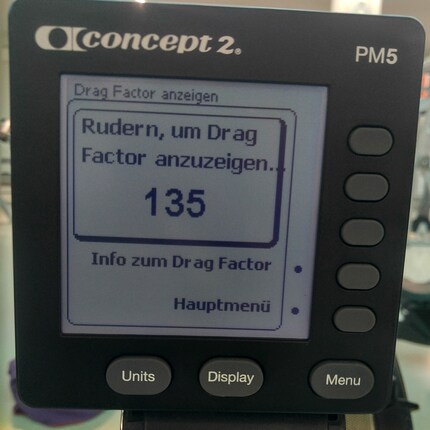
Background information
Rowing like there’s no tomorrow – part 2
by Patrick Bardelli

Rowing is more than just endurance training. It's a great full-body workout and combines strength and cardio training in one machine. Which one suits your needs?
If you want to work on your fitness comprehensively at home, there is a lot to be said in favour of a rowing trainer. Nothing against treadmills, cross trainers & Co. whose strengths you can read more about here. But no other machine combines endurance and strength training so efficiently. You burn a lot of calories and use all major muscle groups intensively. In the rowing stroke, most of the power comes from the legs before the upper body and finally the arms come into play. The deep muscle layers, which are very important for your core stability, also benefit. Once you have mastered the technique, you will have a full-body workout that is easy on your joints and really challenges you. Our colleague Patrick Bardelli can tell you all about it and teaches you the right rowing stroke, among other things.
Here, however, we will focus on the equipment. They generate the required resistance in different ways. A good model must not have an idle at the start of the stroke. The resistance must be felt immediately, just as it is with "real" rowing on the water. There are different technical solutions to this, but the following three concepts are the most widespread
Here you use your muscle power to drive a flywheel mass that is slowed down by electric or permanent magnets. A higher flywheel mass enables a smoother rowing motion. The resistance is regulated either manually or, as with the model linked below, automatically. Magnetically braked models are very quiet in operation, even with high resistance, but do not offer quite as realistic a feel as devices that work with air or water resistance. However, they are sometimes significantly cheaper.
To all models with magnetic resistance
Advantages:
Disadvantages:
With employees who work with air resistance, you drive a turbine built into the housing train by train. This creates a certain amount of background noise during powerful rowing strokes. As the air resistance increases exponentially, just like the water resistance, the system offers a very realistic rowing sensation. If you've ever sat on a rowing machine in a gym, there's a good chance it was a Concept2 model. [[productlist:2758790]]
For all models with air resistance
You can change the air supply of the wind turbine via a side air flap and thus adjust the "drag factor". The higher the air supply, the more the wind turbine is slowed down with each stroke. This leads to greater resistance at the start of the pull and feels a bit like you are moving a heavier boat instead of a light racing boat.
How intensively you train does not depend on this setting. Even professionals are not interested in pushing the drag factor higher and higher. Here various Olympic athletes report that the drag factor for all of them is between 110 and 140. Almost all of them steer clear of very high resistances. The appropriately selected drag factor helps you to perform "your" rowing stroke under all conditions or to adapt it to your training goals.


You will not find the drag factor on the scale from 1 to 10 on the air flap, but in the menu of the "Performance Monitor" PM5. This is the training computer on the device. It measures the actual deceleration rate of the wind turbine and displays the corresponding value. Depending on the air pressure and condition of the device, the same flap position can lead to different values. This brief self-calibration allows you to train on any Concept2 and obtain accurate performance data. In short: software and hardware meet professional standards.
Advantages:
Disadvantage:
Devices with water resistance also offer a very realistic rowing sensation and a gentle rippling background noise. You pull, the paddles rotate in the water tank. You pull harder, the resistance increases. In the living area, models with a wooden body look far less out of place than all other variants. On the contrary, they even look good. The fun doesn't come cheap. But there are also cheaper versions that do without wood.
All models with water resistance
What the air supply is for the Concept2 corresponds to the filling quantity for the water tank. Especially at the beginning of the draught, it makes a difference whether you move more or less water. To adjust the resistance, you do not necessarily have to top up or empty the water tank. In the model above, you can change it using a rotary wheel. Water is then pumped between two tanks during the following rowing strokes. It takes a while for the resistance to be adjusted.
If you have found your personal resistance on your device, you may not need this at all. If different people train on it or you want to do intervals at different intensities, this function could be important. The training computer of the Viking 3 AR Plus also takes into account the amount of water filled in to display data such as calorie consumption as accurately as possible. Nevertheless, performance-orientated data collectors are more likely to opt for a Concept2 model. Anyone who loves the style and the water feeling will be perfectly happy with a little less.
Advantages:
Disadvantages:
If you have enough space, you should opt for one of the variants mentioned above. Rowing machines with hydraulic cylinders are much more compact, but can't compete with the larger models in terms of rowing feel. Some models also combine air and magnetic brakes, which ensures greater smoothness at high resistances.
Which model should it be? Now it's your turn! Or take another look at the benefits of cross trainers, treadmills & Co. [[marketingpage:14087]] [[marketingpage:14433]]
Simple writer and dad of two who likes to be on the move, wading through everyday family life. Juggling several balls, I'll occasionally drop one. It could be a ball, or a remark. Or both.
Practical solutions for everyday problems with technology, household hacks and much more.
Show all